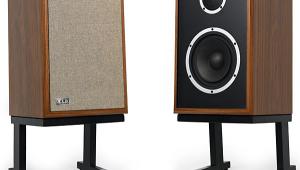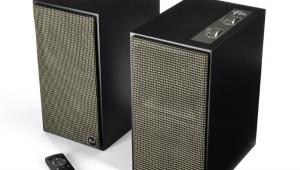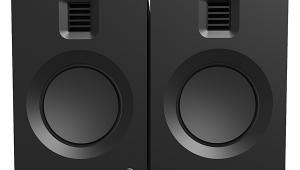Angstrom Suono 600SD Speaker System
 Price: $2,396 At A Glance: Left and right speakers include concealed phantom center • Flat-panel form factor is ideal for wall mounting • Fabric wrap comes in black, gray, or cream
Price: $2,396 At A Glance: Left and right speakers include concealed phantom center • Flat-panel form factor is ideal for wall mounting • Fabric wrap comes in black, gray, or cream
Hide the Center
What’s wrong with this word picture? A sexy flat-panel TV hangs on the wall. On either side of it are some almost equally sexy on-wall speakers, and the screen has a center speaker below it. Let’s assume that surround speakers and a subwoofer are elsewhere in the room. Surely this is a recipe for great audiovisual entertainment.

That is, until something pans across the front three channels. Then, you notice that the sound isn’t panning from side to side, as it should. Instead, it swoops from the left speaker, down to the center speaker, and up to the right speaker again. This isn’t a subtle problem that’s only perceptible to the golden-eared. It is jarring.
The wise home theater buff knows that all three front speakers should be located on the same level (or at least aimed along the same plane). To keep both the screen and speakers on axis from the seating position, the mounts might include some subtle tilting.
But that isn’t the only solution. It also isn’t a perfect one. Some people might reasonably prefer to have the left and right speakers flank the screen, so that panned sounds would seem to pass across the screen surface. In that situation, you’ll need to place the center lower or higher than it should be. Or you could just use a pair of the Angstrom Suono 600SD flat-panel speaker for the three front channels.
You read that right. Two of these speakers can deliver three channels, including Angstrom’s take on a phantom center.
 Phantom Center Hookup
Phantom Center Hookup
The Suono 600SD and Suono 100SD are both 7 inches wide and 3 inches deep. They’re also covered in fabric, which effectively conceals the drivers. Removable gloss-black end caps (two in the 34-inch-tall Suono 600SD, one in the 14-inch-tall Suono 100SD) conceal cylindrical spring-loaded speaker terminals.
The Suono 600SD and Suono 100SD combine front- and side-mounted drivers, including a 1-inch silk-dome tweeter and a 4-inch coated-paper-cone woofer. The smaller Suono 100SD has two woofers on the front, with one tweeter between the woofers, and two more tweeters that fire to each side. The side tweeters account for the SD in the model name, which stands for Spatial Diffuser. A toggle that’s hidden with the speaker terminals can make a 6-decibel cut in the level of the front tweeter.
The larger Suono 600SD is best thought of as two speakers in one enclosure arranged in a mirror-imaged pair. The top half of the enclosure contains what Angstrom calls “half of a center speaker.” That portion houses a woofer and a tweeter just below it, with the tweeter toward the right edge of the left speaker, or toward the left edge of the right speaker.
To some people—including at least two of my editors—this arrangement flies in the face of the settled arrangements of surround sound. If you place a center speaker between the front left and right speakers, it anchors dialogue and some effects, especially for listeners who are sitting off center. By altering the conventional front left-center-right speaker array and moving the center’s guts to the left and right speaker enclosures, this product risks eliminating the center’s reason for existing. If you sit at the sides, the effect might be no better than the phantom center we’re accustomed to from stereo sources. So does Angstrom’s rethinking of surround’s front-of-the-room gold-standard speaker placement work well, or does it not work at all?
The bottom half of the Suono 600SD enclosure functions as a left or right speaker. It contains two woofers that face the front, with one tweeter smack between them. Another tweeter on the side of the enclosure fires outward, away from the center position.
Hooking up the Suono 600SD requires an unusual move. You’ll split your A/V receiver’s center-channel output, with feeds going to dedicated center drivers in both the left and right speakers. I used a double banana plug adapter to combine the two sets of cable at the AVR end. The front left and right channels run from the AVR to the front left and right speakers, as usual.

Associated equipment included the Rotel RSX-1550 A/V receiver and OPPO BDP-83SE disc player.
This Center Has Teeth
As part of normal setup, I ran the AVR’s test tones and used an SPL meter to balance them. The center tone was emphatically present—this was a full-bodied center channel, not a thin simulation. However, I noticed that the tones were pitched differently for the center, front left/right channels, and surround left/right channels. This indicates some unevenness in tonal balance. The speaker designer said this was a deliberate strategy to firm up the center and keep it from getting vague.




























































